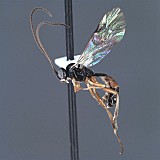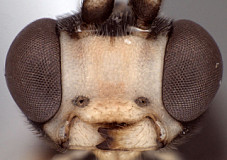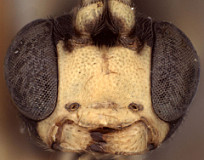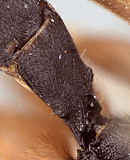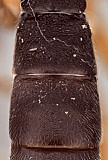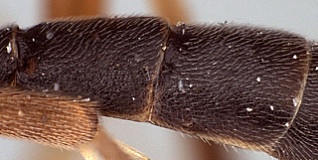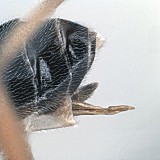Frons without median horn or elevated carina. Clypeus (Figs 2, 3) variable: generally wide; ventral margin blunt and more or less evenly convex in some species (Fig. 2), strongly bulging subapically, with rounded bulge interrupting medially the otherwise sharp apical margin (Fig. 3); epistomal sulcus distinct, sometimes sharply setting off face from bulging (in profile) clypeus. Malar space equal to or shorter than half basal width of mandible, very short in some individuals. Mandible (Figs 2, 3) curved, often gradually narrowing from base to apex; ventral tooth varying from slightly to distinctly longer than dorsal tooth. Inner eye margins parallel to weakly converging ventrally. Ocelli small in material examined, with maximum diameter of lateral ocellus distinctly shorter than distance between ocellus and eye. Antennae equal to or longer than body; first flagellomere long and slender, about twice longer than second (Fig. 1). Hypostomal carina joining occipital carina above base of mandible; occipital carina complete. Epomia absent. Dorsal end of epicnemial carina usually extending to anterior margin of mesopleuron or nearly so; mesopleuron ventrally mat to polished or nearly so, coarsely punctate. Notaulus varying from absent/weak to sharply impressed on anterior declivity, and varying from absent/weak on disk to distinct at least to level of tegula. Pleural carina distinct, well developed in the material available for study; propodeum with lateral longitudinal carina well developed between posterior margin and spiracle, sometimes weak to absent anteriorly; petiolar area with well-elevated ridges in form of a broad, wide semicircle as in
Campodorus and many other mesoleiines, median longitudinal carinae extending as usually well developed parallel or anteriorly converging ridges from base of petiolar area to anterior margin; narrow areola sometimes separated by a weak carina from basal median area; anterior transverse carina otherwise absent; posterior transverse carina distinct medially, present laterally between lateral longitudinal carina and pleural carina in one of the specimens examined. Legs with apical comb on posterior side of hind tibia short but often well developed, sometimes weak to nearly absent; hind tibial spurs long, slender (Fig. 1), longest spur often equal to half length of basitarsus; all tarsal claws apparently simple, not pectinate. Fore wing areolet usually present; stigma not exceptionally broad, with Rs+2r arising from basal 0.4-0.5. Hind wing with first abscissa of CU1 equal to or longer than 1cu-a. T1 (Fig. 4) gradually widening posteriorly; dorsal carinae very well developed basally, bordering deep basal depression of dorsal tendon attachment, and usually extending posteriorly beyond level of spiracle; dorsal-lateral carina sharp and distinct from base to apex; glymma deep, broad basally, narrowing posteriorly. S1 short, not extending to level of spiracle, 0.3-0.35 times length of T1. T2 thyridium present; laterotergites of T2 and T3 completely separated by creases. T1 and T2 mat to rugulose and coarsely punctate. Ovipositor (Fig. 7) short, straight, with deep, broad subapical, dorsal notch. Apex of female metasoma as in Fig. 7.
This description is modified from Townes (1970) and based on two species in the Texas A&M University Collection.

